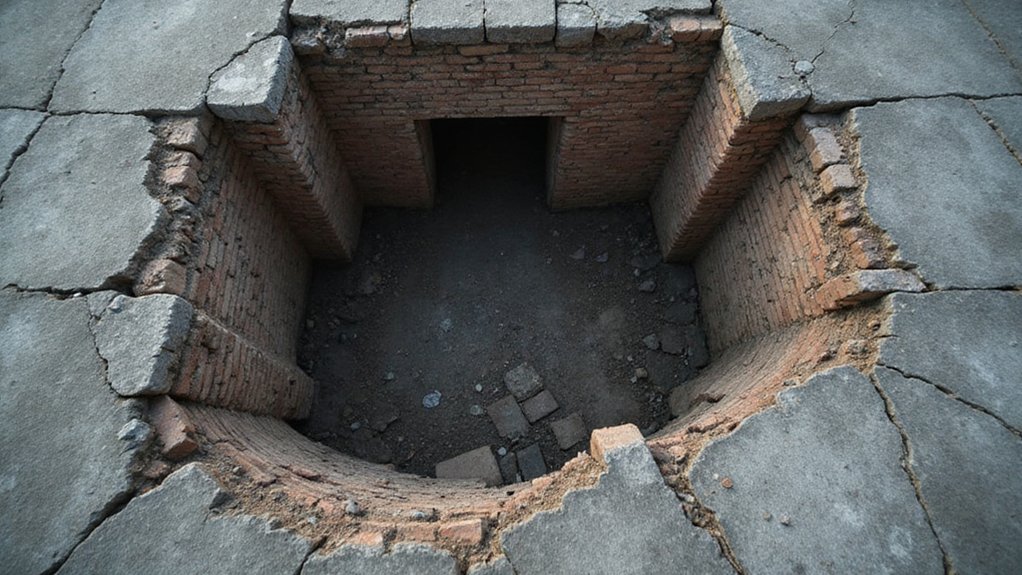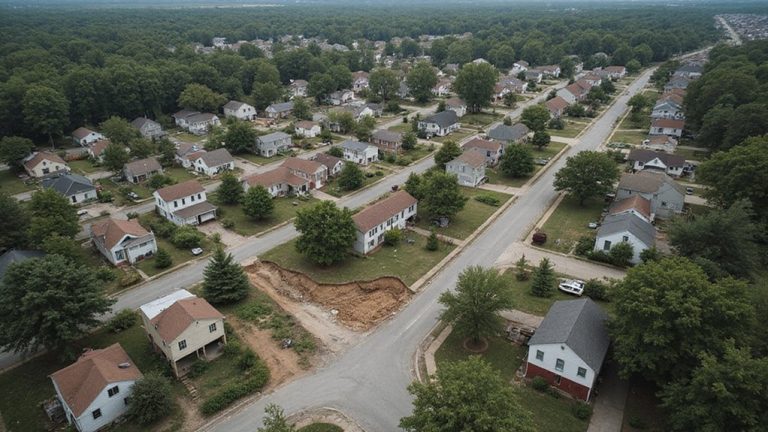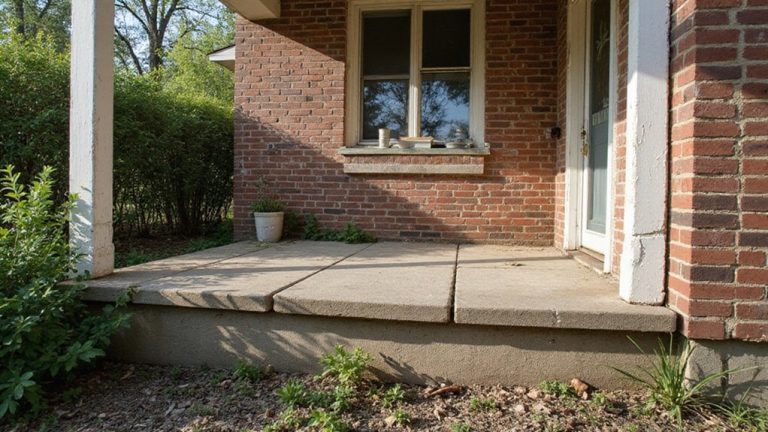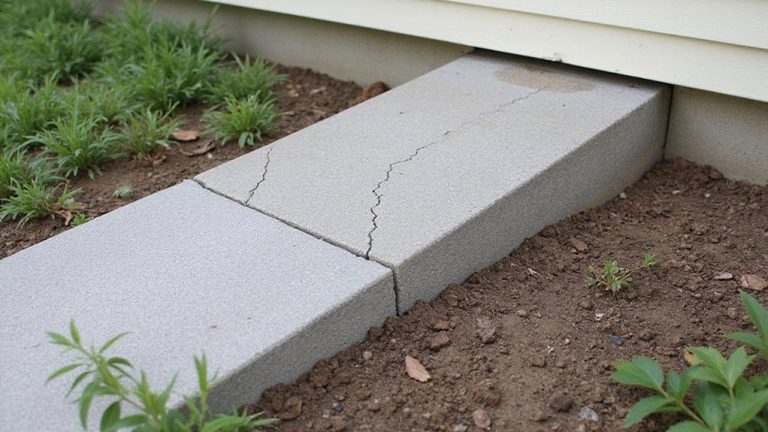Bowing walls are a serious symptom of foundation problems that shouldn’t be ignored. They signal underlying structural issues, often caused by soil or water-related factors. Neglecting these warning signs can lead to costly repairs, safety concerns, and eroded property value. Addressing the root causes is essential to preserving your home’s integrity, but the next steps may not be obvious. Understanding why bowing walls require prompt attention is the first step in protecting your investment.
Causes of Bowing Walls
Bowing walls can be a worrisome issue for homeowners, as they often signify underlying foundation problems. One common cause is soil compaction. Over time, the soil supporting your home can become compressed, causing the foundation to sink and the walls to bow outward.
Groundwater issues, such as leaks or poor drainage, can also contribute to this problem by eroding the soil and destabilizing the foundation. If you notice your walls starting to bow, it’s essential to address the issue promptly to prevent further damage and costly repairs. Addressing the root causes can help restore the structural integrity of your home. Horizontal wall cracking can indicate severe foundation stress caused by factors like soil moisture and ground temperature variations.
Identifying Bowing Walls
If you’ve started to notice your walls bowing inward or outward, it’s important to take action. Bowing walls are a serious structural integrity indicator and a common wall defect. They can signify foundational problems that, if left unaddressed, can worsen over time.
Look for cracks, gaps, or spaces between the wall and floor or ceiling. Walls that aren’t plumb (perfectly vertical) are another red flag. These issues may seem minor, but they require prompt attention from a professional.
Identifying bowing walls early on can help prevent more extensive and costly foundation repairs down the line. Soil pressure and roots can cause significant structural damage to basement walls if not addressed promptly.
Risks of Neglecting Bowing Walls
Neglecting bowing walls can lead to severe consequences, both structural and financial. Ignoring this critical issue can result in:
- Deteriorating property value as the structural integrity of your home declines.
- Increased safety concerns, as bowing walls can compromise the stability of your entire building.
- Costly repairs that may become necessary if the problem is allowed to worsen over time.
- Potential legal liabilities if the structural issues lead to injuries or damages.
Acting promptly to address bowing walls is essential to protect your investment and safeguard the well-being of your family.
Impact on Structural Integrity
Unaddressed bowing walls can substantially compromise the structural integrity of your home, potentially leading to catastrophic failures. As the walls continue to shift, they disrupt the overall foundation, causing other settlement patterns that snowball into larger problems.
Over time, this can lead to cracking, sagging floors, and doors that no longer close properly. Unabated soil erosion around your home’s perimeter further destabilizes the foundation, exacerbating the issues. Ignoring bowing walls allows these problems to spiral, jeopardizing the safety and value of your most significant investment. Addressing the cause of the bowing walls is vital to preserving your home’s structural integrity.
Signs of Foundation Damage
Often, the first signs of foundation damage are visible on the surface of your home. You’ll want to keep an eye out for these common indicators:
- Foundation cracks, whether large or small, horizontal or diagonal, can signify a shifting foundation.
- Uneven flooring, such as sloping or sinking, may point to soil issues beneath your home.
- Sticking doors or windows can result from a shifting foundation.
- Cracks in exterior or interior walls are another potential sign of foundation problems.
Addressing these issues promptly is vital to maintain your home’s structural integrity and prevent further damage. Overlooking the signs of foundation damage can lead to expensive repairs down the line.
Preventing Further Wall Bowing
Promptly addressing wall bowing can help prevent further damage to your home’s structural integrity. Reinforcing measures like installing wall braces or anchors can stabilize the foundation and halt the bowing process.
Specialized stabilization techniques, such as foundation underpinning or soil reinforcement, may be necessary in severe cases. These professional interventions can restore your walls to their proper alignment and safeguard your home’s value.
Don’t delay – acting quickly on wall bowing issues can save you from costly and dangerous structural problems down the line. Your family’s safety and your home’s well-being depend on it.
Importance of Professional Inspection
When it comes to wall bowing, you shouldn’t try to tackle the problem on your own. Opting for a professional foundation inspection is essential for a few key reasons:
- Experts can accurately identify the root cause and extent of the issue, ensuring you get a proper diagnosis.
- They’ve the specialized knowledge and tools to assess the structural integrity of your home.
- Professional inspections are cost-effective in the long run, as they can recommend timely repairs to prevent further damage.
- Ignoring wall bowing can lead to more serious and expensive foundation problems down the line.
Addressing Bowing Wall Issues
If you’ve noticed your home’s walls bowing inward, it’s indispensable to address the issue without delay. A professional assessment is vital to determine the root cause and recommend proper solutions.
Proper drainage around your home’s foundation is often a key factor, as excess moisture can weaken the soil and lead to wall bowing. Additionally, waterproofing considerations may be necessary to prevent further damage.
Don’t wait – addressing bowing walls promptly can protect your home’s structural integrity and prevent more extensive (and costly) repairs down the line. A proactive approach is the best way to safeguard your investment.
Frequently Asked Questions
Can Bowing Walls Be Fixed Without Major Repairs?
Bowing walls can be fixed through interior reinforcement options and structural adjustments, but you’ll need to carefully consider the underlying issues. It’s not a quick or simple fix, so you’ll want to get professional help.
Is Bowing Wall a Common Issue in New Homes?
Bowing walls are not uncommon in new homes. Proper foundation inspection and use of modern construction materials can help identify and address this issue before it becomes a grave concern. Following expert recommendations is pivotal for maintaining a sturdy home.
How Much Does It Cost to Fix Bowing Walls?
Fixing bowing walls can cost anywhere from $500 to $10,000 or more, depending on the extent of the damage. A foundation inspection and structural engineer evaluation are essential to determine the best repair approach and associated costs.
Can Bowing Walls Worsen Over Time if Left Untreated?
Yes, bowing walls can worsen over time if left untreated. This indicates structural integrity concerns and potential foundation issues that need prompt attention to preserve your home’s safety and value.
How Long Does It Take to Repair Bowing Walls?
Repairing bowing walls usually takes several weeks. Permanent wall supports and structural reinforcement techniques like carbon fiber straps or steel beams can stabilize the walls, but you’ll need to consult a professional for your specific situation.



